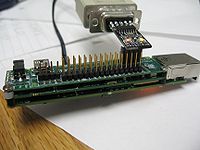Difference between revisions of "Gumstix Verdex"
| Line 18: | Line 18: | ||
;Note | ;Note | ||
| − | :It fails if there are any error messages so follow all the installation requests until it starts | + | :It fails if there are any error messages so follow all the installation requests until it starts saying it is "Handling BitBake files"... |
To make an image to burn onto the gumstix use: | To make an image to burn onto the gumstix use: | ||
Revision as of 17:10, 3 June 2010
Installing the build environment
The main instructions are on the gumstix.net wiki, but that page has several details that are now obsolete. Here are the steps I did:
mkdir ~/gumstix cd ~/gumstix svn co https://gumstix.svn.sourceforge.net/svnroot/gumstix/trunk gumstix-oe cat gumstix-oe/extras/profile >> .bashrc . .bashrc
gcc-4.3 gives a lot of errors, but gcc-4.1 works so far There is a problem documented here about duplicate getline functions.
Then to set up a cross-compilation environment:
bitbake gcc-cross
- Note
- It fails if there are any error messages so follow all the installation requests until it starts saying it is "Handling BitBake files"...
To make an image to burn onto the gumstix use:
bitbake gumstix-basic-image
where "gumstix-basic-image" is a recipe from the directory gumstix-oe/com.gumstix.collection/packages/images/
The cross-compiler binaries can be found in:
gumstix-oe/tmp/cross/bin/arm-angstrom-linux-gnueabi-*
Compiling
To set up build environment
source ~/gumstix/gumstix-oe/extras/profile
Executables for cross-compiling are stored in:
/home/brian/gumstix/gumstix-oe/tmp/cross/arm-angstrom-linux-gnueabi/bin
And the PATH can be set with:
PATH=$PATH:/home/brian/gumstix/gumstix-oe/tmp/cross/arm-angstrom-linux-gnueabi/bin
To compile
arm-angstrom-linux-gnueabi-g++ cgi.cpp vfatregister.cpp vfatedit.cpp vfati2c.cpp -o vfat$i.cgi -lcgicc
And if you need to link against cgicc (for web interfaces) add both of the arguments
-I/home/brian/gumstix/gumstix-oe/tmp/work/armv5te-angstrom-linux-gnueabi/libcgicc-3.2.3-r0/cgicc-3.2.3 -L/home/brian/gumstix/gumstix-oe/tmp/work/armv5te-angstrom-linux-gnueabi/libcgicc-3.2.3-r0/cgicc-3.2.3/cgicc/.libs
Flashing the gumstix
Serial Com using Macbook USB
I was able to use the USB port of my Macbook pro to communicate with the Gumstix using a USB to serial cable and a serial adapter plugged into the gumstix board.
Minicom and the Virtual comport driver were two pieces of software I needed to install on the Macbook.
The first software was a Virtual COM port driver available at
http://www.ftdichip.com/Drivers/VCP.htm
after installing I restarted the Macbook and found the following file had been installed
bash-3.2$ ls /dev/tty.usb* /dev/tty.usbserial-FTC9IF6E
The next step was to install minicom. Minicom was easy if you have already install MacPorts. The command is
sudo port install Minicom
You now need to set the port driver location within minicom using the -s switch
minicom -s
speed baud parity and stop bit = 115200 8N1
- Note
- The driver only shows up if the USB-Serial cable is plugged in. You don't need something plugged into the serial port.
If the Gumstix won't boot, you can (rather slowly) flash the filesystem over serial.
If the gumstix will boot, then flashing from RAM disk over ssh is faster, but if the process fails or gets interrupted you'll have to fall back on the serial method. Remounting the filesystem read-only may not work, and the whole processed failed. Reflash over ssh
Changes necessary from the default image
Boa config
Boa is a webserver designed for small/embedded platforms
In /etc/boa/boa.conf change the following lines:
| From | To |
|---|---|
| #ServerName www.your.org.here | ServerName gumstix |
| ScriptAlias /cgi-bin/ /usr/lib/cgi-bin/ | ScriptAlias /cgi-bin/ /var/www/cgi-bin/ |
Stop and then start boa with:
/etc/init.d/boa stop /etc/init.d/boa start
Add the following files
These are the files for the cgicc (C++ cgi script) library. Copy from the bitbake to the /usr/lib/ directory
- libcgicc.so.5
- libcgicc.so
- libcgicc.so.5.0.1
Install additional packages
ipkg install libstdc++6
Suid cgi-bin
Programs that run I2C directly need to be suid as root so they have permissions to make I2C system calls.
chown root /var/www/cgi-bin/vfat*.cgi chmod u+s /var/www/cgi-bin/vfat*.cgi
Add home PATH
- optional
Make a file in /etc/profile.d/ that contains the following:
#!/bin/sh export PATH=$PATH/home/root/bin:
